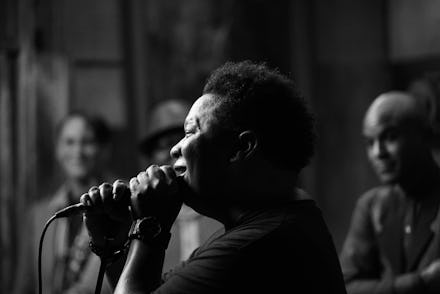Mannie Fresh calls ‘Back That Azz Up’ the greatest love song ever written

The old French Quarter floorboards pulsated under my feet as rivulets of sweat formed along my collarbone. About 20 feet in front of me, the Preservation Hall Jazz Band was cutting up, and despite the lack of air conditioning in the venue — or maybe catalyzed by it — people were catching the spirit. In front of the band stood Mannie Fresh, ad-libbing over the infamous opening seconds of 'Back That Azz Up,' a melodic call-to-action for nostalgic twerkers.
“Turn to someone you like...or love,” he said. “And tell ‘em, this is the greatest love song ever wrote.”
I can’t exactly disagree. The track, which dropped a full 20 years ago, is an exemplary ratch, nuanced, baby-making anthem of my time (if babies were made on dance floors). And that night, I realized that traditional jazz — with its rich, blaring horns — is apparently the perfect bedfellow to the suggestive hip-hop indigenous to Magnolia Projects.
The performance was unprecedented, but felt organic. New Orleans is known as the birthplace of jazz but has actually gestated six whole genres of music: jazz, blues, R&B, zydeco, bounce, and gospel. And on that night at Preservation Hall — where Spotify and the city’s tourism board produced a private concert with 12 quintessential New Orleans’ musical acts — every flavor was present and accounted for.
The concert ran the gamut, featuring old-school legends Irma Thomas and the Dirty Dozen Brass Band as well as rappers Curren$y and Mannie Fresh. Singer Boyfriend did her “rap cabaret” thing and Jonathan Batiste took a night off from his Colbert Show gig to tap into his jazz roots. It was the first time all these artists had shared a stage, playing for a select group of fans and the media. Last week, the live version of the concert dropped in the form of a Spotify playlist, and in the coming months, the performances will be crafted into a film boasting the city’s exuberant musical heritage.
The concert and playlist aim to shine light on New Orleans’ culture beyond the drunken debauchery of Bourbon street. At the risk of sounding self-righteous, I’ve always seen the city as a portal of auditory pleasure. My endless hours spent listening to brass bands on Frenchman street; twerking to DJ Jubilee’s bounce at bar rooms across town; and (mild) participation in Second Line parades are a testament to New Orleans’ musical versatility.
If you don’t know, now you know, I thought, as I watched the crowd at Preservation Hall that night lose themselves in the classiest rendition of 'Back That Azz Up' I’d ever heard (and there have been a few). To call the mash-up a musical gumbo would be trite. This was more like a 2 a.m. Sazerac — bold, complex, and extremely necessary.